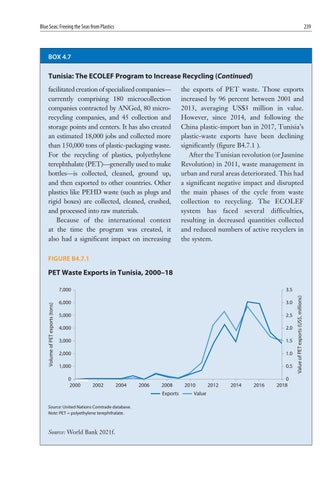Blue Seas: Freeing the Seas from Plastics
239
BOX 4.7
Tunisia: The ECOLEF Program to Increase Recycling (Continued) facilitated creation of specialized companies— currently comprising 180 microcollection companies contracted by ANGed, 80 microrecycling companies, and 45 collection and storage points and centers. It has also created an estimated 18,000 jobs and collected more than 150,000 tons of plastic-packaging waste. For the recycling of plastics, polyethylene terephthalate (PET)—generally used to make bottles—is collected, cleaned, ground up, and then exported to other countries. Other plastics like PEHD waste (such as plugs and rigid boxes) are collected, cleaned, crushed, and processed into raw materials. Because of the international context at the time the program was created, it also had a significant impact on increasing
the exports of PET waste. Those exports increased by 96 percent between 2001 and 2013, averaging US$3 million in value. However, since 2014, and following the China plastic-import ban in 2017, Tunisia’s plastic-waste exports have been declining significantly (figure B4.7.1 ). After the Tunisian revolution (or Jasmine Revolution) in 2011, waste management in urban and rural areas deteriorated. This had a significant negative impact and disrupted the main phases of the cycle from waste collection to recycling. The ECOLEF system has faced several difficulties, resulting in decreased quantities collected and reduced numbers of active recyclers in the system.
FIGURE B4.7.1
7,000
3.5
6,000
3.0
5,000
2.5
4,000
2.0
3,000
1.5
2,000
1.0
1,000
0.5
0 2000
2002
2004
2006
2008 Exports
Source: United Nations Comtrade database. Note: PET = polyethylene terephthalate.
Source: World Bank 2021f.
2010 Value
2012
2014
2016
0 2018
Value of PET exports (US$, millions)
Volume of PET exports (tons)
PET Waste Exports in Tunisia, 2000–18






